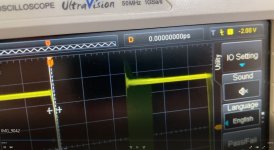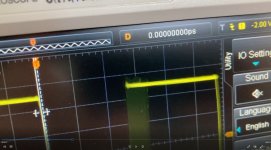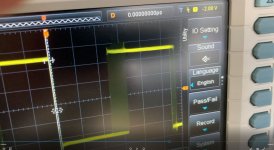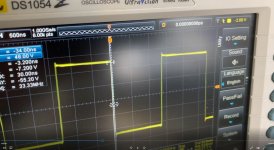Thought I had found the ultimate MosFet for class D
Have been experimenting IPP320N20N3 instead of my usual IRFB5620.
I really though one of my boards was fried as I en the first test got massive ringing.
I mounted another board up with IRFB5620. Only limited ringing (before mounting of snubbers).
Then changed to IPP320N20N3 ...... see pictures!!!
Boards based on IRS2092 with ZXGD3003E6 buffers and 4R7 gate resistors.
Pre + post filter fb.
Data sheet would suggest this is a real good MosFet, fast, lower Rds(on), higher current capability, low Ciss ... all in all better than IRFB5620 !!
Anyone having experience with these Fets?
What am I missing here?
Was your probe ground attached?
All the superjunction mosfets [Optimos/SJ/MDMESH/X2/X3] are trash when used in Class-D applications. They are good in PFC/FORWARD-Converter/Flyback etc. The culprit is abrupt change in CRSS & COSS wrt VDS Graph.
Go with Planar Mosfets instead.
New mosfets are mostly low gate threshold, appx 3V or less. Make it very difficult to control the dead time i.e. gate resistor almost useless.
But I know how, if anyone interested.
Switching freq around 320kHz. Snubber 10R + 100pf.
bypass / decoupling caps right at the mosfet pins.
Green PCB output mosfet is IPP320N20N3, no gate buffers, only 10R + 1n4148 + 4.7R for gate turn off.
Scope traces are from the green PCB.
I used ZXGD on the blue PCB prototype, but it uses IRFB4227. Also I don't have scope traces of the blue PCB because I already sent it on the other side of the globe for evaluation.
Are you Lester in my facebook group?
Hi Kartino
1. Im interested, please PM
2. regarding UCD High Voltage with SPW47N60
what is switching frequemcy ?
Do you have FAQ "DEAD TIME" v/s gate resistor value ?
Im in your FB Group
3. IRFP4227 / 4229 not available at least 6 months to 1 year to buy
Also copy cat ISCSEMI cant provide to sell IRFP4227
Could IRF200P223 work as replacement for IRFP4227 in UCD ?
Datasheet look good
1. Im interested, please PM
2. regarding UCD High Voltage with SPW47N60
what is switching frequemcy ?
Do you have FAQ "DEAD TIME" v/s gate resistor value ?
Im in your FB Group
3. IRFP4227 / 4229 not available at least 6 months to 1 year to buy
Also copy cat ISCSEMI cant provide to sell IRFP4227
Could IRF200P223 work as replacement for IRFP4227 in UCD ?
Datasheet look good
Attachments
Last edited:
Hi 
The UcD high volt is not yet tested by me. The amp is intended as trash recycle actually as in my country there are a lot of used mosfet. Please don't be discussed here. They will bully me
The mosfet IRF200P223 has very low gate threshold (2V). It will need a lot of trial to suit to class D.
We did trial offline. Many people have failed using this fet. They ignore the VGs.
The UcD high volt is not yet tested by me. The amp is intended as trash recycle actually as in my country there are a lot of used mosfet. Please don't be discussed here. They will bully me
The mosfet IRF200P223 has very low gate threshold (2V). It will need a lot of trial to suit to class D.
We did trial offline. Many people have failed using this fet. They ignore the VGs.
Last edited:
Now with a new version of the amp.
4 layer PCB
Rgate 3R3, no snubber With ES1D freewheeling diode which has very minimal effect
+-50V
Not a bad result
Baldin, Do you mind sharing your drive/gate driver stage ?
Hi Kartino
1. Im interested, please PM
PM sent
Baldin,
Which are these mosfets and please check 'ON LOAD' waveforms as well, the real hard switching would be, connecting the output thru resistor to one of the rails.
Mosfets are IPP320N20N3
I do not see change when load is going up.
Intention with the update is only to say that it is for sure possible to use IPP320N20N3 for class-d, but you need to be much more careful of the implementation.
As multi layer PCBs are getting really cheap, I so no reason anymore not to use 4 layer (8 usd at JLCPCB). This together with a relatively tight layout (which can be made even better if I strip it for the bead and anti parallel diode I have made room for.
The gate bead only made the result worse
It's really super simple, 3R3 gate resistor directly between IRS2092S and fets.Baldin, Do you mind sharing your drive/gate driver stage ?
I made room for both a gate bead and an antiparallel diode, but these did not improve anything. I have a ES1D across the fest + room for a simple RC snubber on each fet.
Local decoupling by X7R on rails to GND, and Rail to Rail, relatively close to fets
Another finding with IPP320N20N3 is that they switch slower than expected, and slower than the trusty IRFB5620, and also get markedly hotter in idle (probably because the dead time is a bit on the low side)
Average Rise and Fall times, with same conditions Rgate=4R7, +-50V:
Trise Tfall
IRFB5620 24.6 20.8 nS
IPP320N20N3 35.0 36.9 nS
Nothing too scientific just the readout on the scope.
I really would like to love the IPP320N20N3, not least for the Id = 34, compared to IRFB5620 at 25A, and also the lower Rds 32 compared to 60 mOhm for the IRFB5620
I'm using the IRS2092S at 45nS deadtime ... would like to reduce, in stead of increase ...
Average Rise and Fall times, with same conditions Rgate=4R7, +-50V:
Trise Tfall
IRFB5620 24.6 20.8 nS
IPP320N20N3 35.0 36.9 nS
Nothing too scientific just the readout on the scope.
I really would like to love the IPP320N20N3, not least for the Id = 34, compared to IRFB5620 at 25A, and also the lower Rds 32 compared to 60 mOhm for the IRFB5620
I'm using the IRS2092S at 45nS deadtime ... would like to reduce, in stead of increase ...
Mosfets are IPP320N20N3
I do not see change when load is going up.
Intention with the update is only to say that it is for sure possible to use IPP320N20N3 for class-d, but you need to be much more careful of the implementation.
As multi layer PCBs are getting really cheap, I so no reason anymore not to use 4 layer (8 usd at JLCPCB). This together with a relatively tight layout (which can be made even better if I strip it for the bead and anti parallel diode I have made room for.
The gate bead only made the result worse
Would love to see the waveforms with loaded conditions.
Hi kASD
You are right, under load here playing deep bass in 4 ohm, it is clear that the ringing increases quite a bit under load.
Will try to optimize both drive (Rgate) and add a snubber.
And will also make a comparison to IRFB5620
Note: the measurements done with NOT spring loaded probe ... so this is not a true picture, but a clear indication
You are right, under load here playing deep bass in 4 ohm, it is clear that the ringing increases quite a bit under load.
Will try to optimize both drive (Rgate) and add a snubber.
And will also make a comparison to IRFB5620
Note: the measurements done with NOT spring loaded probe ... so this is not a true picture, but a clear indication
Attachments
Last edited:
Same measurement for IRFB5620.
For sure also a rise in ringing with load, but a bit less.
Still not spring loaded as this was just for comparison. Scope is 100mHz ("hacked" DS1054) and probe 150Mhz .... well that is what I have got ....... yes somewhat on the low side as ringing will probably be btw 50-100MHz
....... yes somewhat on the low side as ringing will probably be btw 50-100MHz
For sure also a rise in ringing with load, but a bit less.
Still not spring loaded as this was just for comparison. Scope is 100mHz ("hacked" DS1054) and probe 150Mhz .... well that is what I have got
Attachments
- Home
- Amplifiers
- Class D
- Massive ringing with IPP320N20N3



